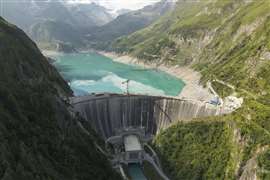Southern hotspot
18 March 2008
![]()
In 2003, it was announced that South Africa would host the Federation Internationale de Football Association (FIFA) Soccer World Cup in 2010. this development has played a large role in kick-starting the construction sector, which had been in a trough.
Tens of billions of Rands are being spent on the 2010 Soccer World Cup, but this is just the beginning of more to come, according to well-placed players in the current construction boom.
“I believe that there is going to be at least eight to 10 years more positive growth going forward. It's massive and real,” said Neil Cloete, managing director of Grinaker-LTA, one of South Africa's largest construction companies that has a sizeable stake in government's infrastructure investment programme. this includes constructing two so-called ‘glory’ projects for the 2010 event-the ZAR 1.50 billion (US$ 220 million) Soccer City project in Soweto, Gauteng, and the ZAR 1.16 billion (US$ 170 million) Nelson Mandela Stadium in Port Elizabeth, Eastern Cape.
“The surface of government's ZAR 400 billion (US$ 58.6 billion) infrastructure spend has not even been scratched. Then there's at least ZAR 300 billion (US$ 43.9 billion) in the mining sector and I would imagine the same in the private sector,” said Mr Cloete.
Sean Flanagan, executive director of operations for Murray & Roberts, another South African construction giant, which is part of the Bombela consortium constructing the ZAR 25 billion (US$ 3.7 billion) Gautrain Rapid Rail Link, a high-speed railway network in Gauteng, reiterated Mr Cloete's sentiments.
“We see post-2010 as the real opportunity and it is what is really exciting us. 2010 is just the catalyst to fix a series of issues we have neglected for 20 years because we've been in a declining industry,” he said. “We're seeing far more opportunity beyond 2010 than we see in the run up to 2010.”
More to come
Both are referring to an array of projects in the energy, transport and water sectors. South African electricity utility Eskom will start fast-tracking its much-needed ZAR 150 billion (US$ 22 billion) capacity expansion plans for the next five years. ZAR 60 billion (US$ 8.8 billion) of this will be spent from 2010 to 2012 on generation and transmission projects, alone.
Meanwhile, national transport company
Transnet, will undergo a ZAR 64.5 billion (US$ 9.39 billion) expansion over the next five to eight years. A massive ZAR 31.5 billion (US$ 4.59 billion) has been assigned to the national railway carrier, Spoornet, for rail logistics infrastructure investment.
The South Africa National Road Agency Ltd (SANRAL), which has been mandated by the South African government to oversee the country's national road network, has purposely delayed several toll road developments until after 2010. this decision was taken in view of the current skills and materials shortages being experienced. “Some construction will only begin in 2014,” said Nazir Alli, chief-executive officer of Sanral.
Meanwhile, half of the Department of Water Affairs & Forestry's total expenditure projects between 2007 and 2013 will be on six of its largest water-augmentation projects with a combined value of ZAR 10.8 billion (US$ 1.6 billion). Five of these will only be completed after 2010.
Opportunities and shortages
The growth of the construction sector over the last few years has provided plenty of opportunities. The shortage of equipment has opened the doors to a number of new suppliers, and Chinese names such as Yuchai, Shantui and Sany are now familiar in the sector. Even so, Dylan Chicken, managing director of McCarthy Heavy Equipment, which is the distributor for these three manufacturers warns that the equipment shortage is expected to continue up to about 2017.
These Chinese machines are of course cheaper than traditional brands such as Caterpillar, Komatsu and Volvo, and their relative simplicity is also seen as an advantage in a country where there is a shortage of skilled operators and technicians. The problem is being compounded by the significant number of HIV/AIDS-related deaths in the construction and equipment sectors.
A lack of skilled workers and machines is not the only problem. Building materials of every kind are in short supply, cement being the biggest concern. The three major suppliers in South Africa are Pretoria Portland Cement (PPC), Lafarge and Holcim and, unfortunately, they have fallen well short in their forecasts of annual cement demand.
Dr Orrie Fenn, chief operating offcer of PPC, said it is doubtful that anybody could have accurately predicted the astronomical growth in demand for cement in the country. According to Dr Fenn, it takes five years from the start of the feasibility studies to the commissioning of a new cement plant. It would, therefore, have been logistically impossible for PPC to have had a new operation in place to meet the rocketing demand.
According to Dr Fenn, from 1971 to 2001, local demand for cement grew by about +2% per year, while growth was negligible between 1995 and 2001. “Then, suddenly in 2002 and 2003, demand increased to +6% per year, rising to +15% in 2004, +9% in 2005 and then to just more than +10% in 2006. The cumulative growth over five years has been more than +50%,” he said.
All three companies have been importing cement, mainly from China, albeit under what is claimed to be an extremely stringent quality regime. this, of course, has opened a gap for new participants in the sector.
A major recent announcement was the entry of China's Tangshan Jidong Cement Company into the South African market. this followed an agreement between South African company, Wiphold, and the Chinese cement giant. The cement's competitive advantage, of course, will be its lower cost.
Meanwhile, Egyptian Orascom Construction Industries will be launching Mafikeng Cement Company, which will build and operate a 2 million tonnes per year plant in the North West Province at a cost of US$ 440 million. this new capacity in cement production will only be available by 2010, reflecting the company's optimism over the post-World Cup construction market.
Foreign heads and hands sorely needed
The biggest concern, however, remains a serious shortage of critical skills in the country. For example, the tunnelling portion of the massive Gautrain Rapid Rail Link project is one of South Africa's largest employers of foreign workers. The majority of candidates found for this part of the project are from the Philippines, according to Malcolm Campbell of One World Human Capital, which recruits skilled workers for the project.
Despite their special skills in underground construction, part of the reason they are recruited is that their salary package is considerably smaller than their Western counterparts. “Candidates from Europe and the UK will be more expensive because there are issues of expatriate allowances. The Philipinos have a standard package that includes a flight home and a small housing allowance,” he said.
The construction of Nelson Mandela Stadium in Port Elizabeth in Eastern Cape and Soccer City in Johannesburg in Gauteng has also been extremely successful in luring foreign skills. Mike Moody, project director of the Grinaker-LTA/Interberton Soccer City Joint Venture, says his organisation has hired about 50 engineers and foremen from the Phillipines and Bangladesh for these projects.
He said the short-term solution of hiring overseas skills was no surprise and he is optimistic that the skills shortage will last only “three years”.
Another effect is that more overseas companies are winning contracts in South Africa. The Chinese Overseas Engineering Corporation (COVEC), for example, is constructing the ZAR 425 million (US$ 62 million) Vaal River Eastern Subsystem Augmentation project, which entails augmenting water supply to Eskom and chemical giant, Sasol's operations in Secunda. Apparently, to the South African government's delight, COVEC undercut bids put forward by two local consortia by -25%, or ZAR 100 million (US$ 15 million).
Wider region
The activity in South Africa is also acting as a catalyst for construction-related activities in countries north of South Africa's borders. Major road redevelopment schemes have already been announced in Zimbabwe, Mozambique, Namibia and Botswana in preparation of the 2010 World Cup. Meanwhile, work forges ahead on the upgrade of airports in Maputo, Mozambique, and Gaborone, Botswana, to cater for the additional forecasted passenger traffic during and after this event.
Like South Africa, the rest of the Southern African Development Community is just as bullish about the future. There are huge power-related projects in the region, the development of a 3600 MW power station in Botswana's Mmamabula coalfields and the expansion of the Morupule power station in the same country.
Meanwhile, the Mozambican government is looking for investors for a new 2400 MW hydroelectric facility on the Zambezi River, about 70 km south of the Cahora Bassa Dam while Eskom has expressed interest in constructing a 100 MW coal-fired power station adjacent to the country's Moatize coalfields.
Zesco, the Zambian national power authority, has entered into an agreement with Tata Africa to build a US$ 150 million hydropower power station in Itezhi-Tezhi on the Kafue River. The 120 MW facility is expected to be completed within three years.
Clearly, a wealth of opportunity has opened up for the international community on the most southern tip of the African continent, and it is only a matter of time before more lunge at the endless prospects.
STAY CONNECTED


Receive the information you need when you need it through our world-leading magazines, newsletters and daily briefings.
CONNECT WITH THE TEAM










